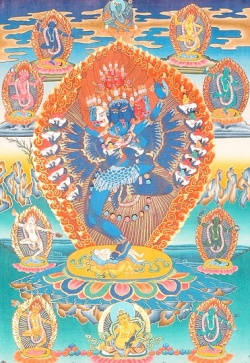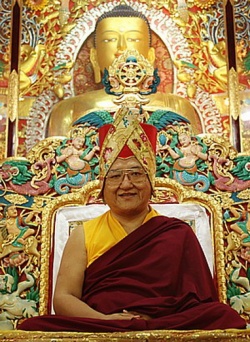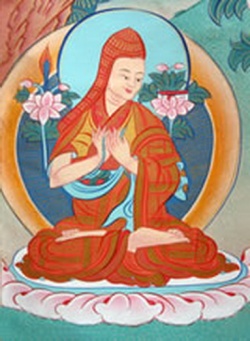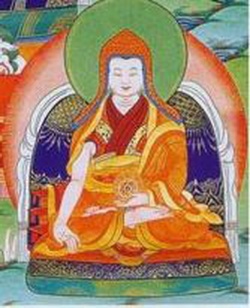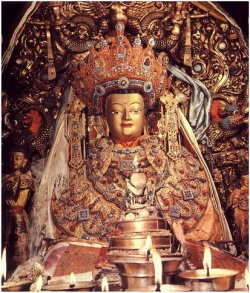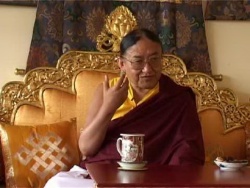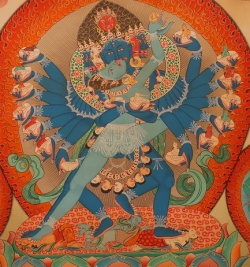Teachings on Tantra
The Philosophy and Practice of Tantra by His Holiness the Sakya Trizin
The Tantric path begins as the Buddhist path. There is no important philosophical difference between Tantric Buddhism and Mahayana Buddhism - the difference is one of emphasis and method. Let us first look at the practical beginning of the Tantric path.
It is said that the Tantric path begins as the Buddhist path, so it is not surprising that the first step on the Tantric path is the taking of refuge. In the Tibetan Tantric tradition, refuge is taken with a qualified Guru who represents a recognised spiritual lineage. In a sense, the act of taking refuge is an initiation. First and foremost, it represents an initiation into the Buddhist religion, and it is the first step that we take on the Buddhist path to liberation.
The reasons for taking refuge in the triple gem are three: fear, faith and compassion. Fear, in the sense that we take refuge in the Triple Gem out of fear of the suffering of samsara; faith, meaning that we believe that only the Triple Gem has the power to relieve us from the suffering of samsara; compassion, because, just as we fear the suffering of samsara, so do all other living beings, and so we take refuge in the Triple Gem for the sake of all living beings.
The next step on the Tantric path is the production of the enlightenment thought (bodhicitta). The creation of the enlightenment thought is closely connected to the vows of the Bodhisattva. In brief, the essence of the Bodhisattva’s practice is the altruistic wish to benefit all living beings. Like the taking of refuge, the creation of the enlightenment thought is a necessary preliminary to the practice of the Tantric path.
The following step is to reflect on death, impermanence and the human condition. We should recognise that the happiness and favourable circumstances that we enjoy at the present moment are not permanent. These will all disappear at the time of death and, moreover, there is no certainty as to when death will occur. Reflecting on death and impermanence encourages us to practise the Dharma without delay.
Next, we should understand the law of karma – or the law of cause and effect, and its relation to our actions. We should come to realise that good actions such as generosity and compassion are the cause of happiness, while unwholesome actions like selfishness and hatred are the cause of suffering. As there is no way of avoiding the results – good or bad - of actions, we should strive to do only good actions and to avoid unwholesome ones.
In the Tibetan Tantric tradition, certain preliminary practices are usually performed before entering the Tantric path proper. The preliminary practices comprise four parts.
The first is the recitation of the refuge formula one hundred thousand times. The second part involves the recitation of the onehundred- syllable Vajrasattva mantra one hundred thousand times. The third part consists of the recitation of a formula in praise of the Guru one hundred thousand times. The last part represents performing one hundred thousand mandala offerings. In this practice, one symbolically offers the universe for the sake of one’s spiritual progress.
The first part of the preliminary practices serves to set us firmly on the Buddhist path. The second is meant to purify us of past and present negative tendencies. The third establishes a strong bond between ourselves and our Guru, while the last helps to rid us of selfish tendencies through the symbolic act of giving, while enabling us to accumulate the merit necessary to be successful on the path.
After completing all these preliminaries, we may ask the Guru for initiation into the meditational practices associated with one of the Tantric tutelary deities – emanations of the Buddha. Initiation into these practices must be given by a qualified Guru who represents a recognised spiritual lineage. Tantric initiation enables us to visualise and identify ourselves with the purified universe of the tutelary deity – the symbolic representation of the enlightened experience.
The similarity that is seen to exist between Hindu and Buddhist Tantra has sometimes led some to assume that what distinguished Buddhist philosophy from its Hindu counterpart had been forsaken with the development of Tantra. This, however, is not true, because Tantra is concerned with the means of achieving spiritual progress, not with philosophy. So the similarity between Hindu and Buddhist Tantric practices is not an indication of Hindu and Buddhist philosophies merging.
The fact, for example, that a number of terms and deities are shared by Hindu and Buddhist Tantra, does not mean that Tantric Buddhism has strayed from the essence of Buddhist thought. For instance, although a number of terms like “svabhava” and “atma” that are commonly found in Hinduism also occur in Buddhist Tantric writings, they don’t have the same meaning. The term “svabhava” which in Hinduism means the existence of an independent nature or essence, is used in Buddhist Tantra to emphasise the emptiness of all things. Thus it is said that the nature of all things is emptiness. Similarly, the term “atma”, or self, is merely used to identify one with emptiness.
The fact that several deities are worshipped by both Hindus and Buddhists does not mean that Buddhist philosophy has lost its distinctive character. In the first place, the Hindu deities included in the Buddhist Tantric pantheon are deities of lesser importance. Secondly, since both Buddhism and Hinduism developed within the Indian cultural context, it is not surprising that a number of deities should be adopted by both traditions. Such deities are in themselves neither Buddhist nor Hindu, but belong to Indian culture.
In short, Tantra is concerned with methodology more than with philosophy. Not only Buddhist and Hindu, but Jain and even Islamic Tantric practices show many similarities. Despite the similarities between Buddhist and Hindu Tantric practices, Tantric Buddhism has always retained its critical philosophical attitude. It was mentioned above that there is no important philosophical difference between Tantric Buddhism and Mahayana Buddhism. Mahayana Buddhism contains two principal philosophical schools or standpoints – that of ‘mind’ and that of ‘emptiness’. These standpoints were explained at length by Asanga and Nagarjuna, who are recognised by the Tibetan Tantric tradition as the fathers of Buddhist Tantra as we know it. And hence, there are two chief elements in Buddhist Tantric philosophy – ‘mind’ and ‘emptiness’.
The focus on the importance of mind is the starting point of Tantric Buddhist philosophy. Mind is the first step in the process of gaining freedom, not the last, because in order to gain freedom, one must also understand emptiness.
The process of gaining freedom is explained in the Tibetan Tantric tradition by means of four steps illustrated by examples. The first step expresses the idea that our situation is dependent upon our mind through a series of examples. When for instance someone has taken alcohol, he may feel that the ground is moving, or that he has great strength. Again, one who is suffering from jaundice perceives white objects as being yellow. These examples show that our perceptions are conditioned by the state of our mind.
The second stage is illustrated by the example of a magical illusion. The point here is that although perceptions depend upon mind, mind itself is illusory. Mind in fact is nothing in itself. It is neither within nor without, neither long nor short. Just as when a magical apparatus is assembled, the magical illusion appears, but when the apparatus is not assembled, the illusion does not appear, so all experience is like a magical illusion.
The third step is to understand all things as interdependently originated. This is also illustrated by means of examples. For instance, if a number of vessels filled with clear water are placed outside on a moonlit and cloudless night, the moon’s reflection will appear in the vessels of water. If any of the conditions such as cloudlessness are missing, the moon’s reflection will not appear. Just in the same way, all things appear as the result of a combination of conditions – that is, they are interdependently originated.
Finally, all things are understood to be inexpressible. This is shown by means of examples like the following one: although a sprout is produced from a seed, it cannot be said either that the sprout and the seed are identical or that they are different. So the relationship between the seed and the sprout is inexpressible. So it is that all things that are interdependently originated are inexpressible in the ultimate sense.
The four steps of Buddhist Tantric theory illustrated in the foregoing examples show how the ideas of mind and emptiness work together. The first step calls for seeing all things as dependent upon mind, while the next three steps call for seeing all things as similar to a magical illusion, interdependently originated and inexpressible – in other words, empty.
So here, mind is the key to changing our way of seeing things. Mind is responsible for the experience of samsara and nirvana. But mind is nothing in itself – it is empty. If mind had a nature of its own, it would always create either samsara or nirvana according to its nature, but mind is like a crystal or a white cloth. If we place a crystal next to a blue or red object, the crystal will appear blue or red accordingly. If we dye a cloth red or blue, it will turn red or blue accordingly. So too with the mind. If it is conditioned by attachment, aversion and ignorance, it appears as samsara, but if it is conditioned by enlightenment, it appears as nirvana – the experience of a Buddha.
It is said that the practice of Tantra can speed up the process of gaining liberation or enlightenment, but why should this be so? It is because Tantra provides more efficient means of changing ordinary experience into enlightened experience. The key to the accelerating effect of Tantric practices is the fact that Tantra employs a variety of powerful psycho-physical forces which it deliberately manipulates in order to achieve more rapid results. This enables one who practises Tantra to achieve quickly – even in a single lifetime - a level of spiritual maturity which it would otherwise take him many lifetimes to realise.
Whoever practises Tantra is concerned with the control and manipulation of psychological and physical energy. He or she seeks to direct that energy toward attaining the goal of enlightenment. The energy is in itself pure since it shares the nature of all things, which is emptiness. Quantitatively, the energy produced from powerful emotions like desire and anger far outweighs that produced from milder emotions. If properly used, these powerful forces may be transformed in such a way as to contribute to our progress toward the goal of attaining enlightenment. Tantra turns the energy of the defilements – desire and hatred – into the means of liberation. So Tantra is a kind of spiritual Judo in which the strength of one’s enemy is used to gain victory over him.Although it is said that Tantra provides a means of achieving rapid spiritual progress, this does not mean that Tantra is an easy path. It requires strict adherence to the rules of good conduct and a sincere and dedicated approach to the practice of the spiritual path. If one brings these qualities to the practice of Tantra, then only is one’s swift progress toward the goal of enlightenment assured.
There is a common misconception among many non-Buddhists (and even among certain Buddhists) that the Tantras are late and corrupt additions to the Buddha’s teachings. This is false. The tantras are genuine teachings of the Lord Buddha, and they occupy a paramount position within the overall framework of the Buddhist doctrine.
Some of the misconceptions about the Tantras stem from their esoteric nature. Since the time of the Buddha, the Tantras were always taught secretly and selectively. For their correct understanding, they have always required the oral instructions of a qualified master; without such explanations, they can easily be misunderstood in wrong and harmful ways. As a follower of this tradition, I too am prevented from discussing most aspects of Tantra here. But it is perhaps permissible in these circumstances to say a few general things about Buddhist thought and practice. For this, I shall base myself on the teachings of our tradition, such as the ‘General System of the Tantras’ by Lobpön Sönam Tsemo.
What is Tantra?
In the Tibetan tradition, the word ‘Tantra’ (rgyud) normally refers to a special class of the Buddha’s teachings, and to the scriptures that embody it. But contrary to its English usage, the word does not usually refer to the whole system of Tantric practice and theory. For the doctrinal system of Tantra, the terms ‘Mantrayana’ and ‘Vajrayana’ (‘Vajra’ or ‘Adamantine Vehicle’) are used instead.
In its technical sense, the word ‘tantra’ means ‘continuous’. In particular, Tantra refers to one’s own mind as non-dual Wisdom; there exists a continuum because there is an unbroken continuation of mind from beginningless time until the attainment of Buddhahood. This continuum, moreover, has three aspects or stages: the causal continuum, the continuum involved in applied method, and the resultant continuum. Sentient creatures in ordinary cyclic existence are the ‘causal continuum’. Those who have engaged in methods of gaining liberation are ‘continuums involved in method.’ And those who have achieved the ultimate spiritual fruit, the Body of Wisdom, are the ‘resultant continuum’. The causal continuum is so called because there exists in it the potential for producing a fruit if the right conditions are met, even though at present that fruit is not actually manifested. It is like a seed kept in a container. ‘Method’ is so called because there exists means or methods by which the result latent in the cause can be produced. ‘Method’ is like the water and fertiliser needed for growing a plant. ‘Fruit’ or ‘result’ refers to the actualisation of the result that was latent in the cause. This is like the ripened flower that blooms when one has planted the seed and properly cultivated the plant.
The Place of Tantra in the Buddhist Teachings
In His infinite compassion, wisdom and power, the Lord Buddha gave innumerable different teachings aimed at helping countless beings of differing mentalities. These teachings can be divided into two main classes: the Sravakayana (which includes the present Theravada), and the Mahayana. The Sravakayana, sometimes also called ‘Hinayana’, is mainly aimed at individual salvation, while the Mahayana stresses the universal ideal of the Bodhisattva, the being intent upon Enlightenment, who selflessly strives for the liberation of all beings, vowing to remain in cyclic existence until all others are liberated. First, the Mahayana or Great Vehicle can also be divided into two: the Paramitayana, or Perfections Vehicle, which we also call the ‘cause vehicle’ because in it the Bodhisattva’s moral perfections are cultivated as the causes of future Buddhahood, and secondly, the Mantrayana, or Mantra Vehicle, which is also known as the ‘Result-Vehicle’ because through its special practices one realises the Wisdom of Enlightenment as actually present.
The Spiritual Fruit to Be Attained through Tantra
The spiritual fruit that is aimed at in both branches of Mahayana practice is the Perfect Awakening or 2012 • NO. 8 • Melody of Dharma 23 Enlightenment of Buddhahood. A Perfectly Awakened Buddha is one who has correctly understood the status of all knowable things in ultimate reality, who possesses consummate bliss that is free from the impurities, and who has eliminated all stains of the obscurations. The latter characteristic, freedom from the obscurations, is a cause for other features of Buddhahood. It consists of the elimination of the three types of defilements: defilements such as hatred and desire, defilements that obstruct one’s knowledge of reality as it is in its multiplicity, and defilements that pertain to the meditative attainments.
The Path that Leads to the Fruit
We speak of a method of spiritual practice as a ‘path’ because it is a means by which one reaches the spiritual goal that one is aiming at. There are two types of paths. One is the common path that leads to inferior results, and the other is the extraordinary path that leads to the highest goal.
Inferior Paths
Some religious or philosophical traditions, while claiming to yield good results actually lead their practitioners to undesirable destinations. For instance, the inferior Tirthikas (certain non-Buddhist Indian schools), as well as those who propound nihilism, only lead their followers to rebirths in the miserable realms of existence. The higher Tirthikas can lead one to the acquisition of a rebirth in the higher realms, but not to liberation. And even the paths of the Sravakayana and Pratyekabuddhayana are inferior, for they lead only to simple liberation, and not to complete Buddhahood.
The Special Path
The Mahayana itself has two major divisions. As mentioned above, these are the Perfections Vehicle and the Secret-Mantra Vehicle. The first of these is also termed the general Mahayana because it is held in common with both Mahayana divisions, whereas the second is termed the particular one because its profound and vast doctrine is not found within the general tradition. The two vehicles derive their names from the practice predominating within them. In the Perfection Vehicle, the practice of the Bodhisattva’s perfections (paramitas) predominates, and in the Secret-Mantra Vehicle, the practice of tantra is the main element . One essential difference between the two Mahayana approaches can be explained by way of their approach to the sensory objects that are the basis for both cyclic existence and Nirvana. In the Perfections Vehicle, one tries to banish the five classes of sensory objects outright. One first restrains oneself physically and verbally from overt misdeeds related to the objects of sense desire, and then by studying and reasoning, one learns about their nature. Afterwards, through meditative realisation, one removes all attachment to them. This is done on a superficial level, through meditatively cultivating the antidote to the defilements, such as by cultivating love as the antidote to anger, and a view of the repulsiveness of the sense objects as the antidote to desire. And on the ultimate level, one removes one’s attachment through understanding and meditatively realising that all of these objects in fact are without any independent selfnature. In the Mantra Vehicle too, one begins by restraining oneself outwardly (the essential basis for one’s conduct is the morality of the Pratimoksa and Bodhisattva), but in one’s attitude toward the sense objects, one does not try to eliminate them directly. Some will of course argue that such objects of sensory desire can only act as fetters that prevent one’s liberation, and that they must be eliminated. Though this is true for the ordinary individual who lacks skillful methods, for the practitioner who possesses skillful means, those very sense objects will help in the attainment of liberation. It is like fire which, when out of control, can cause great damage, but when used properly and skillfully is very beneficial. While for the lower schools the sense objects arise as the enemies of one’s religious practice, here they arise as one’s teachers. Moreover, sense objects are not fetters to realisation by their own nature; rather, one is fettered by the erroneous conceptual thoughts that surround them.
The Superiority of Vajrayana over Paramitayana
The Secret-Mantra Vehicle is superior to the Perfections Vehicle from several points of view, but its superiority primarily rests on the greater efficacy and skillfulness of its methods. Through Mantrayana practices, a person of superior faculties can attain Awakening in a single lifetime. One of middling faculties who observes the commitments will attain enlightenment within seven to sixteen lifetimes. These are much shorter periods than the three ‘immeasurable’ eons required through the Paramitayana practices. But even though the Mantra Vehicle is superior in skillful methods, its view of ultimate reality is identical with the Madyamaka view of the general Mahayana. For both schools, ultimate reality is devoid of all discursive developments or elaborations. One view cannot be higher than the other since ‘higher’ and ‘lower’ are themselves but discursive developments or conceptualisations.
Preparations and Prerequisites for Tantric Practice
The foregoing text has provided a general introduction to a few of the basic ideas of Buddhist Tantra. The real question is how to apply these theoretical considerations in a useful way, that is, how to practise them. The practice of Mantrayana and further in-depth study of its philosophy require first of all a special initiation from a qualified master. Before one can be initiated, one will first be examined by the teacher, who will ascertain whether one is a fit receptacle for the teachings. One’s master may require that one purify and prepare oneself through specific preparatory practices. Finally, after one has been led into the glorious mandala by the master, one begins one’s practice, carefully observing the various vows and commitments of the Vajrayana. These vows are primarily mental, and as such, they can be even more challenging than those of the Pratimoksha and Bodhisattva systems. One must also devote oneself to further study, and to practising specialised visualisations and yogas according to the master’s instructions.
Buddhist Versus Hindu Tantra
Buddhist Tantra is thus distinguished from the other branches of Mahayana by its special methods. It is, however, identical to the Mahayana Madyamaka in its ultimate view, and it is the same as all Mahayana schools in terms of its aim and motivation. Hindu Tantra, by contrast, has a different philosophical basis and motivation, even though it shares some of the same practical methodology. Some persons have suggested that Buddhist Tantra must not belong to pure Buddhism because it shares many elements of practice with the Hindus. This is specious reasoning, because certain methods are bound to be shared by different religious traditions. Suppose we had to abandon each and every element of practice shared with Hindu traditions. In that case, we would have to give up generosity, morality, and much more.
There are, of course, many further differences between Buddhist and Hindu Tantras in their terminologies, their philosophies, the details of their meditative practices, and so forth. But I shall not attempt to explicate them since my own firsthand knowledge is limited to the Buddhist tradition. Here it will suffice to stress that Buddhist Vajrayana presupposes the taking of refuge in the Buddha, Dharma and Sangha (and the Guru as the embodiment of these three), the understanding of Emptiness, and the cultivation of love, compassion and Bodhicitta (the Thought of Awakening). The latter is the firm resolve to attain perfect Buddhahood in order to benefit all sentient creatures, through one’s great wish that they be happy and free from sorrow. These distinguishing features are not found in the non-Buddhist Tantras.
Conclusion
The study of Tantra can only be fruitful if one can apply it through practice, and to do this one must find, serve, and carefully follow a qualified master. If one finds one’s true teacher and is graced by his blessings, one can make swift progress towards the goal, perfect Awakening for the benefit of all creatures. In composing this account, I am mindful of my own immeasurable debt of gratitude to my own kind masters. Here I have tried to be true to their teachings and to those of the great masters of our lineage without divulging that which is forbidden to be taught publicly. I shall consider my efforts to have been worthwhile if some harmful misunderstandings have been dispelled.
